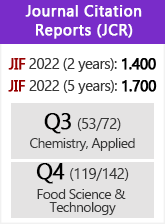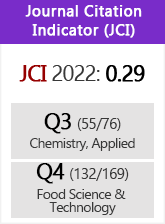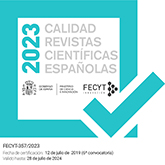Oxidative stability and tocopherol concentration of canola oil extracted using supercritical CO2
DOI:
https://doi.org/10.3989/gya.2006.v57.i2.31Keywords:
Canola oil, Oxidative stability, Supercritical extraction, TocopherolsAbstract
In this work the characteristics of canola seed oil extracted using supercritical CO2 under different conditions and its oxidative stability were analyzed and compared with those corresponding to the oil extracted with hexane. The oil with the lower oxidative stability was that extracted at 276 Kg/cm2. All the oils extracted with supercritical CO2 showed a lower oxidative stability than the oil obtained by hexane extraction. Although the hexane extracted oil did not show a significant difference in its tocopherol concentration, its carotenoid concentration was the highest, which could be a reason for the higher oxidative stability of that oil. The oil extraction rate was constant during the whole extraction period, but the rate of tocopherol extraction was higher at the beginning of the process, which suggests a possible co-solvent effect of the oil itself on these compounds.
Downloads
References
AOCS-Official Methods and Recommended Practices of the American Oil Chemist’s Society, Champaign, 1990, método Cd 12b-92.
Crowe, T.D.; White, P.J., 2003. Oxidative stability of walnut oils extracted with supercritical carbon dioxide. J. Am. Oil Chem. Soc. 80, 575-578. doi:10.1007/s11746-003-0740-y
Christie, W.W, 1973. Lipid Analysis, Pergamon Press Ltd, Oxford, England. Del Valle, J.M.; Aguilera, J.M., 1988. An improved equation for predicting the solubility of vegetable oils in supercritical CO2. Ind. Eng. Chem. Res. 27,1553- 1555.
Farombi, E.O.; Britton, G., 1999. Antioxidant activity of palm oil carotenes in organic solution: effects of structure and chemical reactivity. Food Chemistry 64, 315-321. doi:10.1016/S0308-8146(98)00108-3
Friedrich, J. P.; List, G.R., 1982. Characterization of soybean oil extracted by supercritical carbon dioxide and hexane. J. Agric. Food Chem 30, 192-193. doi:10.1021/jf00109a044
Gomez, A.M.; De la Ossa, E.M., 2002. Quality of borage seed oil extracted by liquid and supercritical carbon dioxide. Chem. Eng. J. 88, 103-109. doi:10.1016/S1385-8947(01)00260-1
IUPAC, Standard Methods for the Analysis of Oils, Fats and Derivatives, 7th Revised and Enlarged edn., Blackwell, Oxford, 1987, Method 2.401.
Malecka, M., 2002. Antioxidant properties of the unsaponifiable matter isolated from tomato seeds, oat grains and wheat rem oil. Food Chemistry 79, 327- 330. doi:10.1016/S0308-8146(02)00152-8
Mohamed, H.M.A.; Awatif, I.I., 1998. The use of sesame oil unsaponifiable matter as a natural antioxidant. Food Chemistry 62, 269-276. doi:10.1016/S0308-8146(97)00193-3
Przybylski, R.; Lee, Y-C.; Kim, I-H, 1998. Oxidative stability of canola oils extracted with supercritical carbon dioxide. Lebensm.-Wiss. u Technol. 31, 687- 693.
Sthal, E.; Schütz, E.; Mangold, H.K., 1980. Extraction of seed oils with liquid and supercritical carbon dioxide. J. Agric. Food Chem 28, 1153-1157. doi:10.1021/jf60232a023
Downloads
Published
How to Cite
Issue
Section
License
Copyright (c) 2006 Consejo Superior de Investigaciones Científicas (CSIC)

This work is licensed under a Creative Commons Attribution 4.0 International License.
© CSIC. Manuscripts published in both the printed and online versions of this Journal are the property of Consejo Superior de Investigaciones Científicas, and quoting this source is a requirement for any partial or full reproduction.All contents of this electronic edition, except where otherwise noted, are distributed under a “Creative Commons Attribution 4.0 International” (CC BY 4.0) License. You may read here the basic information and the legal text of the license. The indication of the CC BY 4.0 License must be expressly stated in this way when necessary.
Self-archiving in repositories, personal webpages or similar, of any version other than the published by the Editor, is not allowed.
















